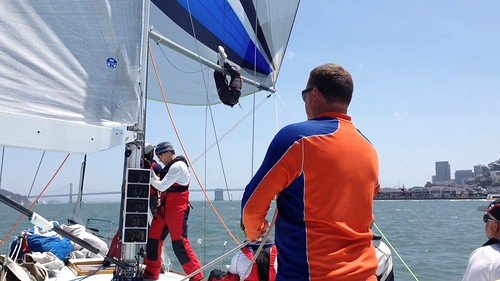
Sailing on a yacht with a symmetrical spinnaker requires the foredeck team, mast, and pit crew to work together perfectly like a well tuned orchestra.
When this post was written in 2017, Zamazaan (Farr 52) attached their Sheets to the Afterguy. Once we updated our rigging a few years ago, we now attach Afterguys to our Sheets. Please keep this update in mind (updated 2022).
A spinnaker peel involves keeping the old kite up so that speed of the boat never suffers, halyard management (inside vs outside hoist), and the bagged new spinnaker on deck. Foredeck team rigs new spinnaker on the same side as the current kite for inside hoist.
Once the tactician calls for a spinnaker peel, the foredeck team asses if the halyards are clear for hoist. In the photo above, we decided to call for an inside hoist and need to clear the starboard halyard. That requires the bow person, in this case me, to climb out the spinnaker pole with the new halyard and bring it around the tip of the pole.
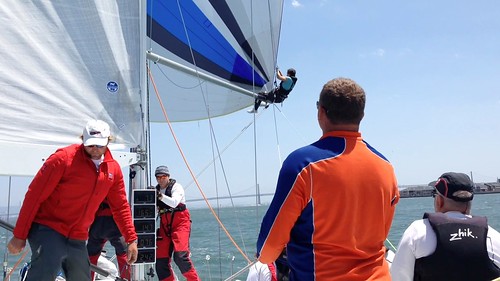
Bringing the new starboard halyard around the tip of the pole and the topping lift (inside old kite). This maneuver is required to not cross the halyards during hoist or douse.
To do this:
- Climb out the pole with the halyard attached to your work belt.
- Once at the tip of the pole, bring yourself and the halyard around the topping lift (inside the kite).
- Climb back down the pole and hand the new halyard to the mid-bow person to manage. Mid bow also handles changing sheets and afterguy for the clew of the new kite.

Unlike a bare-headed change where you would take one kite down before hoisting the other, a peel involves keeping one kite up to keep speed of boat. While the mid-bow person is working on the halyard and changing sheets for the new kite, the bow person attaches the tack of the new spinnaker to harness with a carabiner. Making sure the new kite tack is brought around the forestay before attaching it to the climbing belt.
Next, take the jib halyard and secure it to the climbing harness for safety. Using the climbing anchor attached to your harness, clip on to the foreguy.
Before we go on any further, lets recap:
- New kite brought around the forestay
- The tack of new kite is clipped to climbing belt by carabiner
- Jib halyard attached to climbing harness
- Climbing anchor attached to foreguy
Make direct eye contact with the pit crew who is "on belay" and say, "belay on". Do not start climbing the foreguy until the pit crew is ready to belay. While climbing, keep in communication with crew by saying more tension or give slack.
"Belaying" refers to a variety of techniques used to keep tension on a climbing rope so that in case of mishap, a climber does not fall very far before being stopped by the rope."
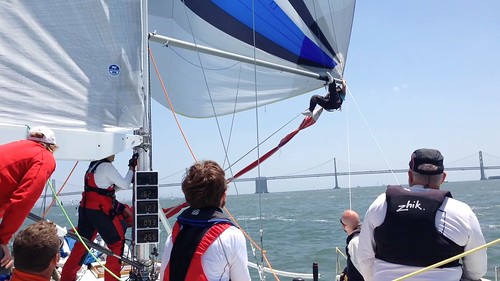
Once at the tip of the pole, attach the climbing anchor to the pole. The anchor holds the bow person in place while performing the next few maneuver.
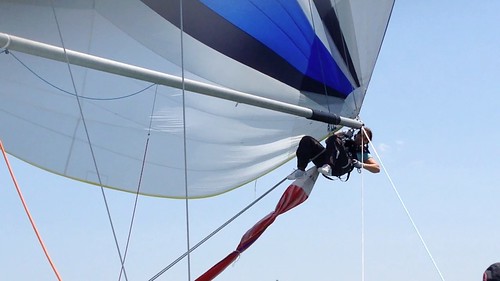
Spinnaker peel linked shackles (or handcuffs) are a permanent fixture on the bow persons belt. Take the linked shackles off your belt and attach one side to the afterguy 'D ring' and the other side to the tack of the old kite.
It's now safe to detach the old tack from the afterguy. The linked shackles will hold the old tack in place while working on the new kite. Remove the new tack from the carabiner on the climbing belt and attach it to the afterguy. Once this is complete, update the crew by yelling, "MADE!".
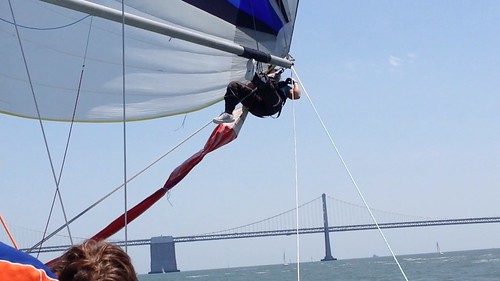
In the above photo you can see the new kite (red) attached to the climbing belt. Note: Attach the new kite to the proper side of your climbing belt.
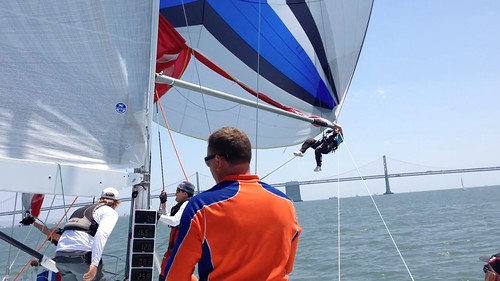
Here the new spinnaker (red) is hoisted by the mast and pit crew. The bow person remains on the pole during hoist and ready to spike the old tack (blue and white) away.
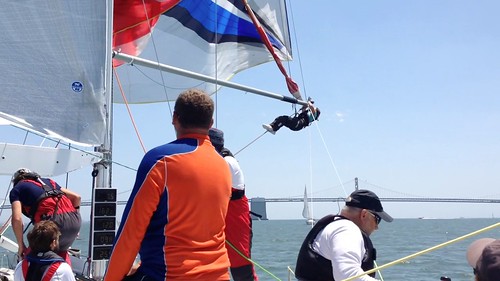
The crew boss with give the call to "spike" the old tack (blue and white), releasing the kite from the pole. It's imperative to spike away to old tack and not the new kite. To do this, find the linked shackles and spike the tack away. Then remove the linked shackle from the afterguy and reattach it you the climbing belt.
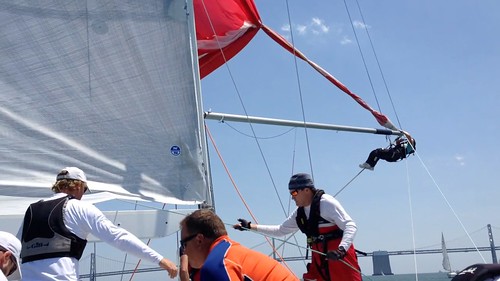
Bow person remains on the pole while dousing the old kite. The new kite (red) waits for trimming.
Here mast and pit crew bring the lazy guy between the boom and the foot of the main sail for a letterbox douse.
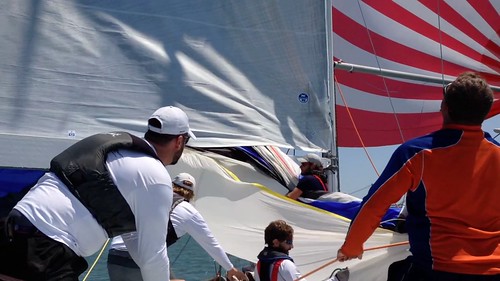
Letterbox douse the old spinnaker and new kite is made.
Letterbox douse is used when sailing during heavy weather or sailing with a large symmetrical kite. Take the lazy guy from leeward on the old kite and run it between the boom and the foot of the main sail. When the douse is called, the pit blows the halyard several feet and the bow person spikes the shackle of the tack on the old kite. The sewer person takes the foot of the spinnaker and hauls it down the companionway. Making sure to gather all the foot of the sail before pulling the head down.
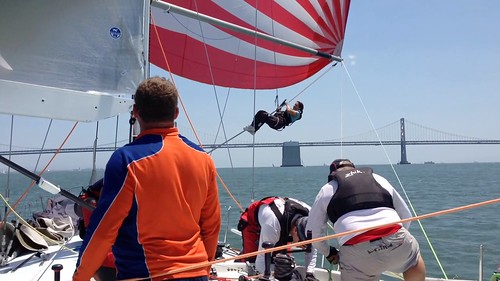
Last, the bow person is lowered to the deck and the foredeck crew detaches old spin gear, re-runs lines, and repacks kite.
I will gather more information regarding changing sheets and afterguy, pit crew and mast.








































